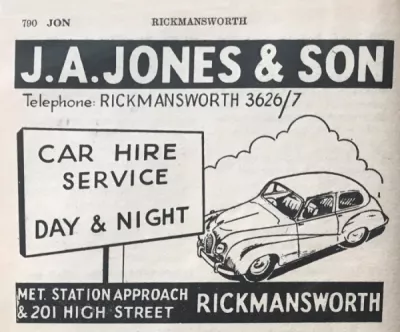G Jones and Sons
The coming of the motor car

The arrival of the motor car in about 1900 has had very considerable effects, few of which can have been foreseen at the start. The roads were the first elements to need changing, as the huge popularity of the bicycle from the 1870s brought pressure from the middle classes for improvement (noisy and heavy steam traction engines chewed them up again – very unpopular, and defended against by the 1861 and 1865 Locomotive Acts). The bicycle was quickly motorised, and became very popular (in 1924 there were more motor bikes than cars in Britain), and the motor car came here from Germany in the late 1880s – by 1900 Herbert Austin was building cars in Birmingham.
One of the first cars owned in Rickmansworth is reputed to have been by Dr Henderson in about 1905, and in 1904 Stephen Beeson certainly had an American car. The 1904 Motor Car Act recognised the effect on people living on roads used by cars, and laid down various measures to control their use, but the die was cast. Here, the Urban District Council was asked in 1904 and 1905 to seek extra powers to slow the traffic in the town (from 20 to 10mph), and a few years later both the Uxbridge Road at Mill End and Church Street were widened expressly to make room for the motor car.
In Rickmansworth, George Jones, born in 1852, was well placed to serve this new requirement. One of a long line of Hertfordshire wheelwrights, his father John (whose wife Martha was of the Peacock family, founders of the Watford Observer) had set up in the late 1830s a coachbuilding business in the High Street next door to the Weslyan chapel, and moved to Church Street when his premises (and the chapel) were burned down in 1865. By 1861 John, already parish clerk for over twenty years, had been joined in the business by his sons, John, Robert and Thomas, although it was George, then only 9, who was eventually to take over and run the business (and the parish clerkship) after John’s death in 1888. It developed well, and George came to own several premises in and around the town, as well as hiring both coaches and horses and providing riding lessons. In 1892 the firm built Rickmansworth’s new fire engine, and an ironic fire in 1894 only slowed the development of the firm, which was ready to adopt the motor car before WW1.



George Jones’s oldest son John Edward (‘Pep’) and Bert both served in WW1. George left the business in 1933 to ‘Pep’, while Bert was to a large extent the manager behind the scenes, as an employee. During this time Jones made wooden truck cabs for Scammell exports to the tropics; built taxis at the ‘West End works’ on part of the site now occupied by Marks and Spencer (directed by the second brother, Arthur, they operated from the Metropolitan Railway station); had the workshop and showroom (above which ‘Pep’ and his family lived) at 23/25 Church Street; and had an electrical retail and repair business next to Boots in the High Street. They had a petrol and service station on the Chorleywood road where the Shell station now is, and similar presence at Croxley Green and as far out as Aylesbury. In the 1930s the High Street premises at The Cloisters were designed and built as a large car showroom, selling mainly Austins with the occasional Rolls Royce.
George had already bought the George Inn in the High Street (54-56) when it closed before WW1, and established a large garage workshop there, complete with petrol pumps. The two rooms at the front became shops – later, a toy shop run by Kay Mendelssohn, and a bicycle shop.
Following the death of ‘Pep’ in 1954 the business was sold to the large London motor dealer H.A. Saunders, but still managed by Bert. On his death in 1959 it was broken up in various ways, but the motor business of G. Jones & Son had become very extensive, and left a strong mark on the town.
We are very grateful for the detail supplied by Mr Tom Jones, the son of Bert Jones, whose memory has enhanced the records we already have.